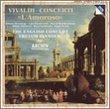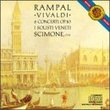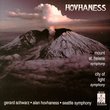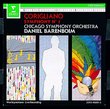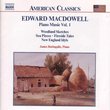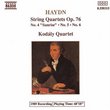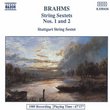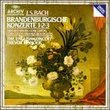| All Artists: Samuel [Composer] Jones Title: Jones: Roundings/Cello Sonata Members Wishing: 0 Total Copies: 0 Label: Naxos American Release Date: 10/17/2000 Genre: Classical Styles: Chamber Music, Historical Periods, Classical (c.1770-1830), Symphonies Number of Discs: 1 SwapaCD Credits: 1 UPC: 636943907924 |
Search - Samuel [Composer] Jones :: Jones: Roundings/Cello Sonata
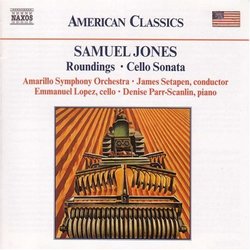 | Samuel [Composer] Jones Jones: Roundings/Cello Sonata Genre: Classical
|
Larger Image |
CD DetailsSimilar CDs
Similarly Requested CDs
|
CD ReviewsA New Deal for Music Lovers Alton Thompson | Taipei, Taiwan | 06/01/2001 (5 out of 5 stars) "The music of Samuel Jones represents a distinctive voice in the American symphonic tradition. Though expressive, his is not a shrill voice screaming agonized wails over the crisis d'jour; though intelligent, this is not the drone of an academic serving up sonic algebra for other academics. The music of Samuel Jones grows from the same soil that nourished composers like Harris, Ives, Copland, and Barber. This is a seasoned voice, deep and assured, that celebrates timeless questions at the same time that it sings of the here and now.Samuel Jones wrote "Roundings: Musings and Meditations on Texas New Deal Murals" for the Amarillo Symphony's seventy-fifth anniversary season. "Roundings" is a symphonic suite in seven movements: (1) "Prologue: Hymn to the Earth," (2) "Windmill," (3) "Oil Well," (4) "Locomotive," (5) "Lariat," (6) "Plow," and (7) "Epilogue: To everything there is a season." Each tool represented in the titles features circular motion of some kind. As the composer describes it in the liner notes of the CD: "Each movement of 'Roundings' takes its point of departure from one of the public murals created during the Depression era under the auspices of Franklin Roosevelt's New Deal.... The title of the suite refers not only to the circular motions depicted in each of the murals, but also to the large cycles represented in life itself."The entire piece lasts 41'01" with individual movements lasting between 2 and 8 minutes. The movements have been programmed as stand-alone pieces as well as movements in the suite; each one, like New Deal art itself, features bold colors and clear outlines. The harmonic language is tonal and rich. Cyclic elements abound: motives that invert and then right themselves, themes that return to the points where they started, and recurrences and inversions of all kinds. The movements vary in tempo but their varied paces inhabit a larger overall tempo effect: a moderate walking tempo, neither hurried nor slow. This overarching pace absorbs the crackling foreground rhythms of work and machine as they propel each moment forward with sure energy. The orchestration -- by turns warm, metallic, earthy, and breezy -- weaves cowboy songs, church hymns, train whistles, and vast landscapes into a world that is pure orchestra. At one point the sound of an actual Depression-era tractor becomes a vital and bracing participant in the ensemble. Each movement opens with a cello solo. These lyrical soliloquies invite gentle commentary from the winds (woodwinds, playing chords) and fill a role in "Roundings" much like the Promenade theme in "Pictures at an Exhibition." Each one pulls us from the picture momentarily and puts us in the place of the viewer who thoughtfully strolls through the gallery. The cello solos remind us that we not only contemplate the work of inland farmers in this piece, but the work of the painters who portray them. Art thus takes its place alongside farming, cattle driving, oil drilling, and electricity production as productive labor -- just one more way we fuel ourselves from the bounty of the world around us. Is Roundings a beautiful piece? Yes-provided your definition of "beautiful" makes room for goods more wholesome than simple ear candy. Here is a suite that contains no sugar and no saccharine, just oats and wheat and barley. Its music sings in gestures both simple and robust.After the orchestral murals of "Roundings," the bare texture of cello and piano almost comes as a shock in its intimacy. Jones wrote his Cello Sonata for a couple celebrating a wedding anniversary. Its three movements (fast-slow-fast) span twenty minutes. Here we encounter Jones's style at its most romantic, and you can spell that with either an upper or lower case "R." The middle movement interweaves an earlier love song, written by the composer to set a text by Elizabeth Barrett Browning, with personal recollections of Beethoven cherished by the work's dedicatees. The musical structure of the sonata, in fact, draws its inspiration from marriage: two chords interact and dance with one another until both resolve into a single new chord that combines elements of both. The Cello Sonata satisfies on a number of levels, but listeners who admire Beethoven's music for cello and piano will especially appreciate what the composer has achieved here.Emmanuel Lopez handles all cello solos on this recording. He gives each solo in "Roundings" its own eloquence while at the same time providing a fine sense of continuity and growth as the protagonist progresses through each movement. Pianist Denise Parr-Scanlin joins Lopez for the Cello Sonata and the combination is something special. The musical results indeed resemble a successful marriage: passion and warmth kept in just enough control to give joy form. The Amarillo Symphony presents both works in an accomplished manner. Those who know the Amarillo Symphony from their earlier performances of the Jones Third Symphony "Palo Duro" will be astonished at the level of increased artistry this ensemble has attained in just a few years. Credit goes to the dedicated Amarillo players and to music director James Setapen for a standout job of orchestra building.Congratulations to producer Blanton Alspaugh for a bold addition to America's digital repertory. In this CD music lovers can enjoy fresh, exciting new works in a quality recording for a civilized price. This is my first taste of the American Classics series offered by Naxos and I can't wait to explore the rest. (Por favor, Naxos-how about a recording of the Jones "Desert" oratorio?)All this for under [money]? Incredible. If you're a lover of good music who has learned to be wary of the new stuff, you can relax and take the plunge on this one. The water's fine." Beautiful, personal music Alton Thompson | 01/03/2002 (5 out of 5 stars) "My daughter and I enjoyed part of Roundings at a Seattle Symphony concert last fall. We were thrilled when Samuel Jones stood up from the audience to acknowledge his talent as a composer. I'm from a farm family and have always loved the hymn We Plow the Fields and Scatter. Dr. Jones uses the hymn tune (which unfortunately has disappeared from our hymn book) in the section Plow. The Seattle Symphony sounded better than the Amarillo but maybe it was just the wonderful sound in Benaroya Hall.The cello sonata is also wonderful. This CD is a real bargain." Naxos wins again! Robert Badger | Philadelphia, PA | 11/22/2004 (5 out of 5 stars) "Klaus Heymann and Naxos have shown themselves to truly be the world's leading classical music label. In terms of sheer repertoire, they can't be beat. Their devotion to American music is praiseworthy.
Samuel Jones is a composer solidly in the American tradition of Copland and Harris. He is a very skillful composer, and unlike many composers, seems to excell in both program music (such as Roundings) and abstract music (such his Cello Sonata). I enjoyed every minute of this disc, and to anyone who loves American music, I urge you to purchase it. The playing of the Amarillo Symphony is quite wonderful. The city of Amarillo and Maestro James Setapen is to be praised for putting together such a wonderful ensemble." |

 Track Listings (10) - Disc #1
Track Listings (10) - Disc #1

